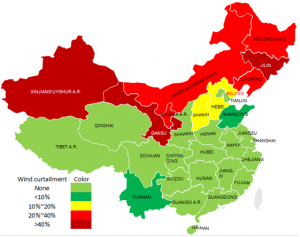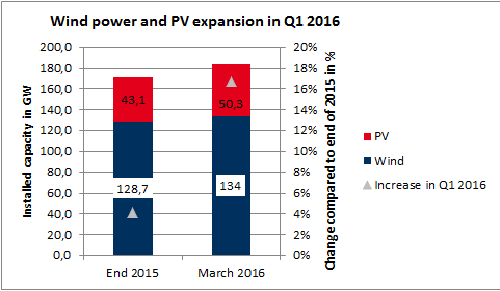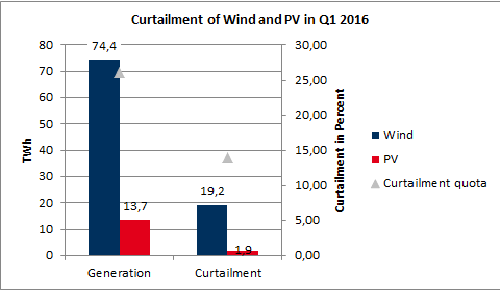Strong expansion of wind and solar power in China still gives rise to high curtailment rates. Now, a new national guideline with regulations for a guaranteed electricity feed-in, as well as programs for better utilization of renewable electricity on the provincial level are in place.

Sources and further information with kind recommendations of Azure International.
Just until the end of March 2016 China expanded its wind power capacity by 5.33 GW, while PV power plants with 7.3 GW where finished as well. Currently, 134 GW of wind power are installed in China. This corresponds to a 33 percent increase from levels in March 2015. The additional PV capacity that has been installed in the first quarter of 2016 has been even higher than the one of wind. As figure 1 depicts, the PV capacity stands at 50.3 GW.

Source: Energy Brainpool
Figure 1: Wind power and PV capacity (left axis) and expansion (right axis) during Q1 2016
The fast expansion of electricity generating capacity of wind onshore and PV along with a combination of regional concentration of renewable energy hubs far away from the load centers along the Chinese east coast and the lack of transport capacity of the extra high voltage network, caused high curtailment rates for electricity from those renewable energy sources in the first quarter of 2016. China’s National Energy Administration (NEA) published the curtailment rates of the first quarter.
Figure 2 shows that more than a quarter of the electricity generated by wind turbines was not fed into the grid. A similar trend, albeit with lesser consequences, can be perceived when looking at solar PV. The provinces most prone to curtailment were Gansu, Xinjiang, Ningxia and Jilin.

Source: Energy Brainpool
In order to reduce high curtailment rates of renewable energies, the NEA published an implementation guideline for guaranteed purchase of renewable electricity. It clarifies that a governmentally determined minimum quantity of electricity from renewable energies has to be accepted by grid operators. The feed-in tariff is also determined by governmental departments and aims at providing an average return of investment of 8 percent for operators of renewable energy power plants. In case the grid operator fails to accept the minimum quantity of electricity, the operators of renewable energy plants are to be compensated by operators of other generation units, for example, thermal power plants. If the quantity accepted by the grid operator exceeds the guaranteed quantity, the electricity does not receive the usual feed-in tariff, but has to be auctioned or directly marketed.
In addition to this national level guideline, the National Development and Reform Commission (NDRC) announced pilot programs for the efficient utilization of renewable electricity in three Chinese provinces. In Gansu, Jilin and Inner Mongolia, surplus of electricity is to be reduced through deliberate actions. The pilot programs focus on the extension of the transmission network, the expansion of the distribution network as well as on the further electrification of industrial processes. In addition, renewable electricity is increasingly to be sold via market-based instruments. Thus, these pilot programs should also evaluate the effect a more liberalized power market in the sense of the aspired power market reform has on the curtailment of renewable energies.



